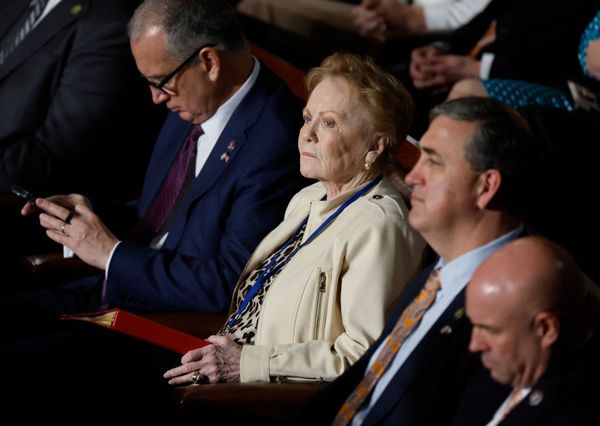Bappi Lahiri, the composer-singer who made India jive to his foot-tapping tunes for at least three decades, passed away on Tuesday. Since the 1980s, Lahiri’s disco numbers have been a hook for youth to gravitate towards the dance floor as he had a remarkable ability to create simple yet infectious tunes that could be enjoyed on loop. No wonder, for millennials who love hook lines, Bappi- da, as he was fondly called, became a pop icon with whom they could have fun.
No wedding procession in the Hindi heartland could last the distance without “ Bambai se aaya mera dost” (from the film Aap Ki Khatir, 1977) and “Jimmy Jimmy aaja aaja” ( Disco Dancer, 1982), which sounds unusually secular these days. And no sangeet ceremony would be complete before new and wannabe brides danced to “ Mujhe naulakha manga de re” ( Sharaabi, 1984).
At the top of his game, Lahiri composed music for a hero who held a gun in one hand and a microphone in the other, and for a heroine who was no longer coy about her desires. If in the 1970s, the angry young man had made the melodies superfluous with his brooding intensity, by the 1980s, that fellow had kicked his way into clubs and pubs — materialistic spaces — that were forbidden for the Nehruvian hero of the 1950s and 1960s. He wanted to dance like John Travolta and punch like Bruce Lee, a combination that gave birth to the phenomenon of “Gun Master G9” (S urakksha, 1979, and D isco Dancer, 1982). Lahiri’s disco beats gave voice to this restlessness in the air. A series of songs such as “ Koi yahan aha nache nache”, “ Rambha ho”, “ Mere jaisi haseena”, “ Jhoom jhoom baba”, “ Jawani janeman” and “ Zooby zooby” reflected this boisterous energy of an India breaking free from its socialist past.
Lahiri was hugely responsible for the rise of Mithun Chakraborty as a counterforce to Amitabh Bachchan, and for resurrecting the career of Jeetendra, with almost a dozen hits in a row. He introduced us to the dramatic contralto of Usha Uthup and Alisha Chinai, and was equally at ease working with Lata Mangeshkar and Samantha Fox.
Born as Alokesh Lahiri into a musical family in Kolkata, Lahiri emerged on the scene as a teenage prodigy at a time when greats like S.D. Burman, O.P. Nayyar and Shankar-Jaikishan were still ruling the charts, and a new breed headlined by Kalyanji-Anandji, R.D. Burman and Laxmikant-Pyarelal had found their feet. After a brief struggle, Lahiri broke through the stiff competition with Z akhmee, C halte Chalte, and Aap Ki Khatir. At 26, he had already composed his swansong in “ Chalte chalte mere ye geet yaad rakhna”, and by the early 1980s, he had put most of his contemporaries in shade.
He was not a one-trick pony as many would like us to believe. At the top of the disco wave, Lahiri was simultaneously composing for remakes of Tamil and Telugu hits such as Himmatwala, Tohfa, Maqsad, and Mawali that demanded traditional melodies and folk tunes. Lahiri would say that 40% of his success came because of the faith bestowed on him by big banners from the south to compose for Tamil and Telugu films as well.
In the same year, he could deliver a “ Gori hai kalaiyan” ( Aaj Ka Arjun) that would play at the neighborhood paan shop, a Tamma taama loge ( Thanedar) that would keep restaurants and bars buzzing, and “ Humko aaj kal hai intezaar” (Sailaab) that would keep the discerning interested.
He inherited a sense of classical music from his parents, Aparesh and Bansuri Lahiri, proponents of Shyama Sangeet. Trained in tabla, Lahiri had a profound side to him as well, which was reflected in compositions like “ Mana ho to tum behad hansi, aise bure hum bhi nahin” from the little known Toote Khilone. Written by Kaifi Azmi and sung by K.J. Yesudas, it underlines Lahiri’s range. Nobody remembers Toote Khilone but the riff is enough for most of us to complete the mukhda: “ Dekho kabhi to humein pyar se, darte ho kyon iqrar se”. So does the simple romantic melody of “ Haan pehli baar”, one of the best songs by Kishore Kumar, which makes the listener believe that there could well be such a thing called love at first sight. That it was part of a little-known horror film Aur Kaun? is but trivia.
Few remember the Hasrat Jaipuri ghazal, “ Kisi nazar ko tera intezar aaj bhi hai” rendered beautifully by Bhupinder Singh and Asha Bhosle in the little known Aitbar (1985), was also composed by Lahiri. When he turned to production, Lahiri backed Buddhadev Dasgupta’s award-winning Lal Darja and followed the maverick filmmaker's instruction not to visit the sets.
He remained underrated as he never hankered for critical acclaim and was content with his mass appeal. He would love to talk about the overwhelming popularity of his number “Jimmy Jimmy” across the nations of the erstwhile Soviet Union but had to be pushed to talk about the timeless “ Inteha ho gayi intezar ki” that hasn’t lost its grace with time. He would rather talk of how he made Amitabh Bachchan rap in “ Jahan chaar yaar”, when nobody had heard about the form. Or for that matter, “ Pag ghungroo bandh Meera nachi thi” ( Namak Halal), the 12-minute number in free verse that even bamboozled Kishore Kumar, whom he fondly called mama (maternal uncle) as he was a related to him.
Among the first Bollywood composers to create a distinct image globally, his concerts became a rage because of his music that crossed boundaries and his unique sartorial sense that covered his portly figure on the stage. Lahiri once told this journalist, “Gold is part of my identity. I want to be known as ‘bling bling Bappi’.” Inspired by Elvis Presley, for Lahiri, his gold chains were like the golden cross that Presley wore or the shades that Michael Jackson loved to sport. Most of the chains that he flaunted had religious symbols of different faiths. “They bring me luck,” he said.
Like his love for gold, he flaunted his fame — the number platinum and silver discs that he scored was always on his fingertips — but deep inside, he was a simple, god-fearing man who wore his popularity lightly. With him, music-making seemed as simple as breathing. He truly believed in “ Zindagi mera gaana, main isi ka deewana”, the Disco Dancer number. If he liked someone, he would create a song for them, then and there. Instead of telling filmmakers what to use, he would offer them a range of tunes to choose from.
There came a time in his career when he became obsessed with numbers and the quality dipped. He was often charged with plagiarism for good reason but Lahiri always called it “inspiration” and often underlined how his songs have found their way back into the west. Marvel Studios used “ Jhoom jhoom baba” in the promotional clip of Guardians of the Galaxy, and Lahiri won a suit against rapper Dr. Dre for plagiarising his number “ Kaliyon ka chaman” ( Jyoti).
Not against the idea of remixes, he would say that it meant his compositions were timeless. They indeed are, as we recently saw Deepika Padukone dancing in gay abandon to “ Koi yahan aaha naache nache” in the commercial for an international apparel brand. Every year, we watch Hindi films, where remixed versions of his songs find space in contemporary storylines. Perhaps that’s how Lahiri was able to keep himself relevant as a playback singer when most of his contemporaries could not. Be it “ Mumbai bajariya” ( Taxi No 9211) or “ Ooh la la” ( The Dirty Picture), Lahiri became the go-to singer for composers who wanted to evoke a sense of nostalgia.
He is survived by his wife Chitrani, daughter Rema, and son Bappa, who is also an established composer.







